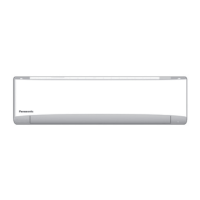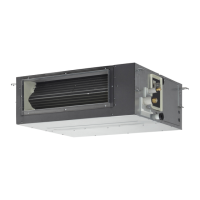2-61
Design of VRF SYSTEM
4. Optional Parts
Fig. 2-167
5. Securing the External Electronic Expansion Valve After Connection with Tubing
After connection with tubing, secure the external electronic
expansion valve using the supplied clamps (large) to hold it
against the gas tube. (Fig. 2-167)
Liquid tube
Clamp (large)
Gas tube
Clamp (large)
Be careful not to tighten the clamps with excessive force, in order to avoid deforming the
tubing or other parts.
NOTE
Fig. 2-168
Connection of External Electronic Expansion Valve with Extension Cord
●
(1) Turn the power off.
(2) Turn the power on. (This step is unnecessary if the model does not have an electronic expansion valve.)
(3) Wait 1 minute after the power is on and then turn the power off again at the mains.
(This step is unnecessary if the model does not have an electronic expansion valve.)
* The electronic expansion valve becomes full-open in the 1 minute.
Do not give instructions for operation through the remote control during this time.
(4) Open the electrical component box. From the control PCB, disconnect the connector to the indoor unit internal electronic
expansion valve. (This step is unnecessary if the model does not have an electronic expansion valve.)
(5) Connect the external electronic expansion valve. (Fig. 2-168)
Connect the external electronic expansion valve connector to
the indoor unit control PCB (PMV or T6).
After completing the wiring process, close the cover of the
electrical component box.
* With some models that do not include an electronic expansion
valve, a relay connector is included. Connect this relay connector.
(6) Turn the mains power breaker back on.
This procedure is now completed.
WARNING
Be sure to turn the power off at the mains before removing or connecting connectors to avoid
electric shock hazard.
Connector for PMV or T6
PCB
Indoor unit
Connect to relay connector
(certain models only)
Wiring Procedure
Wiring Procedure (Using the Attached Cable)
Fig. 2-169
Depending on the model of indoor unit that is connected, this product may require the use of a supplied connector-converter
cable. Refer to the below for the corresponding units and the method of use.
If the indoor unit control PCB has a 5P plug, use the supplied connector-converter cable.
The connector-converter cable is used by connecting it to the
extension cable (8 m) that runs from the electronic expansion
valve unit. (Refer to Fig. 2-169)
After connecting the connector-converter cable, follow the
above wiring procedure and connect the cable to the indoor
unit control PCB.
* Depending on the model, a relay connector may be connected
on the indoor unit control PCB. If this supplied cable is used,
disconnect the relay connector and connect the supplied cable
directly to the indoor unit control PCB.
Electronic expansion valve
extension cable (8 m)
Connect directly to the indoor
unit control PCB (PMV or T6.)
If the model of indoor unit has a relay connector
already installed, disconnect the relay connector.
Connector-converter cable
6P connector
5P connector
Using the connector-converter cable
●
●
TDxxxxxx-002WAYVRF.indb61TDxxxxxx-002WAYVRF.indb61 2014/01/3017:52:322014/01/3017:52:32

